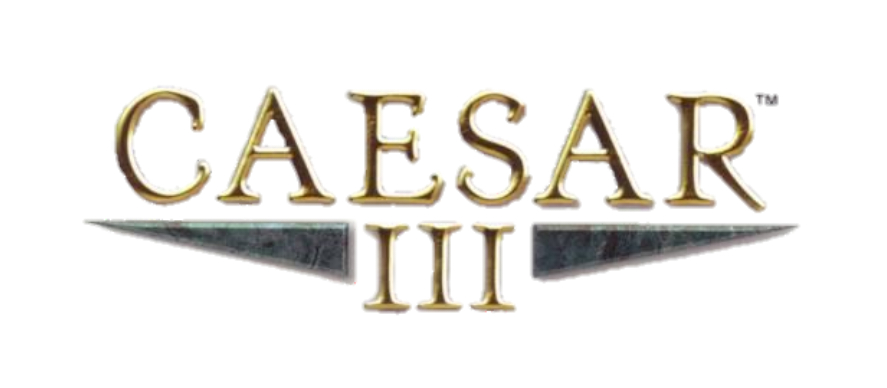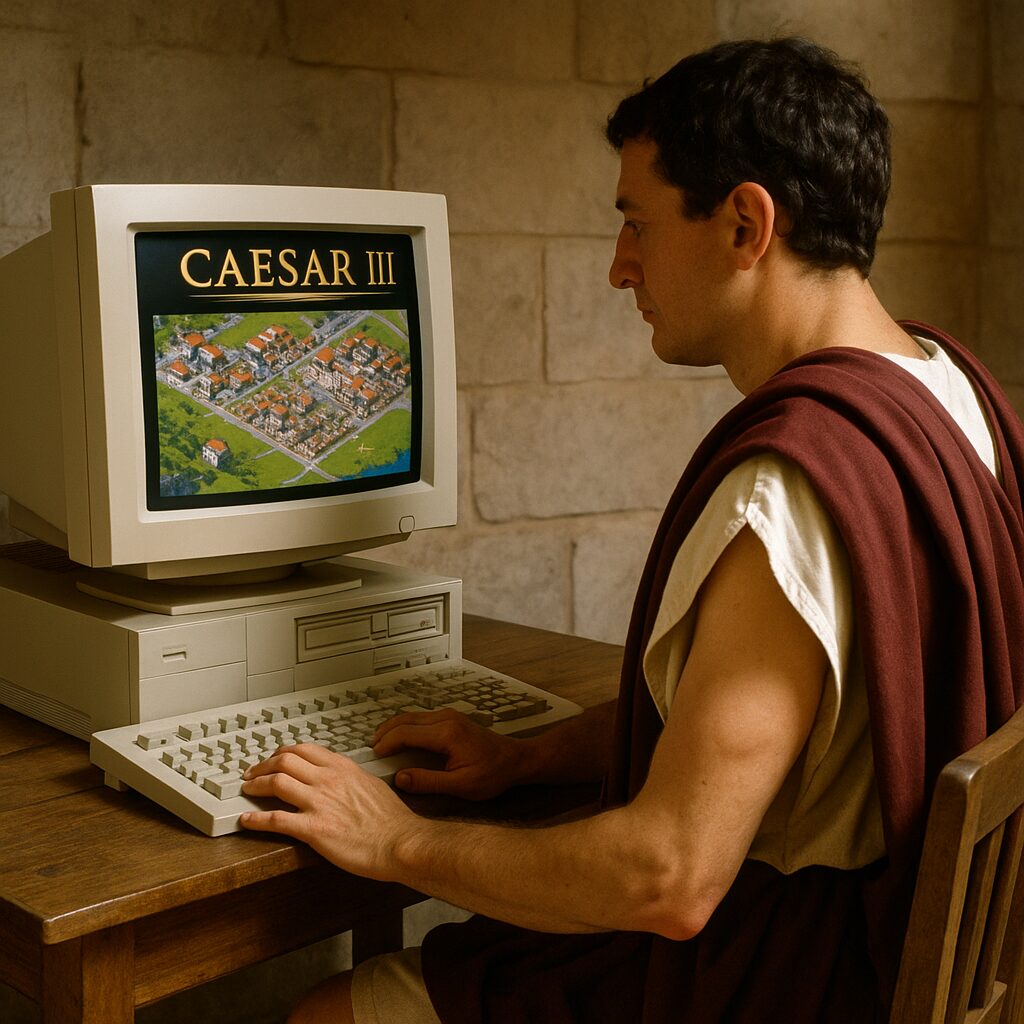For those who love ancient Rome, there is one game series that has delivered such an immersive, educational, and oddly nostalgic experience as the Caesar game series. To be honest, I am one of them. This game, almost as old as me, was originaly developed by Impressions Games and later Sierra and Tilted Mill. In the Caesar game series, the players can step into the sandals of a Roman governor and build the Empire’s cities from scratch. It wasn’t just about roads and houses—it was about culture, class, religion, and the constant looming threat of barbarian invasions.
Decades later, the series still holds a special place in the hearts of fans of Roman history and classic strategy games. It’s more than just pixels and polygons—it’s the sound of Roman horns, the bustle of a forum, and the quiet satisfaction of watching your plebs ascend to patrician villas. Yet, everything has to end at one point, and as the games progressed, there is a clear line of growth and peak, followed by decline.
Caesar I (1992) – Where It All Began
The first Caesar game was a bold idea for 1992. Imagine SimCity, but with a Roman twist—add amphitheaters, temples, aqueducts, and legions, and place it all in the volatile world of ancient provinces. Players took on the role of a provincial governor, juggling urban growth with taxes, morale, and threats from external enemies.
Graphically simple and relatively limited in scope, the Caesar game nonetheless laid the foundation. You could build functioning Roman cities, send troops to repel invasions, and try to maintain the ever-fickle favor of the emperor. It was clunky by today’s standards, but for many history fans, it was their first taste of Roman governance—and it was addictive.
Caesar II (1995) – Bigger Maps, Bigger Vision
Three years later, the Caesar game series returned with Caesar II, dramatically expanding the formula. The game introduced a two-tiered map system: one for your city, and one for the surrounding province. This meant you weren’t just managing a city, you were building Rome’s grip on an entire region.
Players had to control trade routes, deploy legions to patrol borders, and plan city layouts with even more precision. Religious festivals, crime, unemployment, and class stratification became more prominent. Suddenly, you weren’t just placing buildings—you were creating a functioning Roman society.
Caesar II was deeper, smarter, and more complex. But for some, it was also harder to get into. The micromanagement was intense, and the UI could be overwhelming. Still, for us willing to dive in, the payoff was enormous. It felt closer to real Roman rule—and that was the magic.

Caesar III (1998) – The Glory of Rome in Pixels
This was the moment the Caesar game series transcended itself. Caesar III wasn’t just a game—it was a masterpiece, and for many fans, it remains the definitive Roman city-building experience.
Gone were the abstract economic systems. In came a walker-based design: if your citizens needed food, a market lady had to physically walk past their house with it. If they wanted entertainment, an actor had to wander from the theater. Everything was visual, alive, and deeply connected.
What made Caesar III special and the best in the Caesar game series?
- Immersive city design: Roads had to be thoughtfully laid. Poor planning meant your bathhouse workers would never reach the domus on the edge of town.
- Class dynamics: Homes evolved from tents to luxurious villas based on access to goods, services, and desirability.
- Cultural management: Religion, entertainment, education, and healthcare all had to be balanced. Temples and festivals weren’t just cosmetic—they kept the gods happy and the people from rioting.
- Military presence: Invasions were always a threat. Building walls and maintaining legions became part of urban planning.
- Sound and atmosphere: With a rich, ambient soundtrack and lively voice lines (“Ave, Caesar!”), the game felt truly Roman.
The missions were well-paced, each city with its own challenges. Sometimes you were building a rich seaside resort; other times, a frontier town under constant siege. The diversity kept things fresh, and the learning curve felt just right.
Even today, Caesar III has an active player base, a vibrant modding community, and numerous fan-made campaigns. It’s the kind of game that has aged, not like milk, but like wine. If you’re a lover of Roman history or city builders, it’s essential to play it. Actually, I am thinking about diving once again into the Caesar game series, and Caesar III is my first choice.
Caesar IV (2006) – A Modern Makeover With Growing Pains
By the time Caesar IV was released, expectations were sky-high from the Caesar game series. It was the first entry in full 3D, with improved graphics, a new interface, and more complex systems. You could zoom into the streets of your city and watch individual citizens go about their daily lives in more detail than ever before.
But for all its ambition, Caesar IV received mixed reviews. The shift to 3D meant performance issues on many systems. The walker system returned, but felt less predictable and harder to control. Some found the UI clunky and the mission pacing uneven.
Still, the game wasn’t a total misfire. It improved trade mechanics, introduced more dynamic housing systems, and had a more nuanced military component. The sound design and historical flavor remained strong, and for fans eager for a modernized Rome, it delivered enough.
But compared to the charm and balance of Caesar III, it struggled to recapture that magic. It tried to modernize a beloved formula—and in doing so, lost some of its identity. Failure of the game meant an unexpected end for the Caesar game series.
The Enduring Legacy and Modding Community of the Caesar game series
Though the official series stopped at Caesar IV, the spirit of the games never truly died. Caesar III, in particular, has seen a resurgence thanks to community mods and patches. Projects like Augustus and Julius enhance compatibility, visuals, and gameplay mechanics, bringing the classic into the modern age.
The influence of Caesar lives on in games like Pharaoh, Zeus: Master of Olympus, Emperor: Rise of the Middle Kingdom, and even newer indie titles like Nebuchadnezzar. These games carry forward the walker-based city-builder concept, with different cultural themes but the same Roman backbone.
There’s even talk of a revival—spiritual successors or remasters that would bring the Caesar experience to a new generation of players.
Rome Still Stands
So, is the Caesar game series still worth playing today?
Absolutely—especially Caesar III. It remains a masterclass in game design, balancing historical immersion with engaging strategy. The older titles are rougher around the edges but offer insight into the evolution of city-builders. Caesar IV is a mixed bag, but worth exploring for those curious about where the series tried to go.
For fans of ancient Rome, history, or strategic simulation, these games aren’t just fun—they’re educational, atmospheric, and endlessly rewarding. They remind us that even in the world of video games, all roads can lead to Rome.

Hello, my name is Vladimir, and I am a part of the Roman-empire writing team.
I am a historian, and history is an integral part of my life.
To be honest, while I was in school, I didn’t like history so how did I end up studying it? Well, for that, I have to thank history-based strategy PC games. Thank you so much, Europa Universalis IV, and thank you, Medieval Total War.
Since games made me fall in love with history, I completed bachelor studies at Filozofski Fakultet Niš, a part of the University of Niš. My bachelor’s thesis was about Julis Caesar. Soon, I completed my master’s studies at the same university.
For years now, I have been working as a teacher in a local elementary school, but my passion for writing isn’t fulfilled, so I decided to pursue that ambition online. There were a few gigs, but most of them were not history-related.
Then I stumbled upon roman-empire.com, and now I am a part of something bigger. No, I am not a part of the ancient Roman Empire but of a creative writing team where I have the freedom to write about whatever I want. Yes, even about Star Wars. Stay tuned for that.
Anyway, I am better at writing about Rome than writing about me. But if you would like to contact me for any reason, you can do it at contact@roman-empire.net. Except for negative reviews, of course. 😀
Kind regards,
Vladimir
